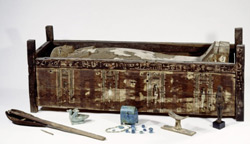The following excerpt is from an article written by Ben Guarino, and posted at the Washington Post website on May 30.
Ancient Egyptians were an archaeologist’s dream. They left behind intricate coffins, massive pyramids and gorgeous hieroglyphs, the pictorial writing code cracked in 1799. Egyptians recorded tales of royalty and gods. They jotted down life’s miscellanies, too, as humdrum as beer recipes and doctor’s notes.
But there was one persistent hole in ancient Egyptian identity: their chromosomes. Cool, dry permafrost can preserve prehistoric DNA like a natural freezer, but Egypt is a gene incinerator. The region is hot. Within the mummies’ tombs, where scientists would hope to find genetic samples, humidity wrecked their DNA. What’s more, soda ash and other chemicals used by Egyptian embalmers damaged genetic material.
A study led by researchers at the Max Planck Institute for the Science of Human History and the University of Tubingen in Germany managed to plug some of those genetic gaps. Researchers wrung genetic material from 151 Egyptian mummies, radiocarbon dated between Egypt’s New Kingdom (the oldest at 1388 B.C.) to the Roman Period (the youngest at 426 A.D.), as reported Tuesday in the journal Nature Communications.
